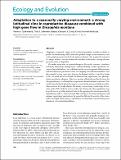Files in this item
Adaptation to a seasonally varying environment : a strong latitudinal cline in reproductive diapause combined with high gene flow in Drosophila montana
Item metadata
| dc.contributor.author | Tyukmaeva, Venera | |
| dc.contributor.author | Salminen, Tiina S. | |
| dc.contributor.author | Kankare, Maaria | |
| dc.contributor.author | Knott, K Emily | |
| dc.contributor.author | Hoikkala, Anneli | |
| dc.date.accessioned | 2015-05-12T16:01:07Z | |
| dc.date.available | 2015-05-12T16:01:07Z | |
| dc.date.issued | 2011-10 | |
| dc.identifier | 185099958 | |
| dc.identifier | a0be8b0d-ecaa-4b79-9d98-e8af36a4c854 | |
| dc.identifier | 84855540178 | |
| dc.identifier.citation | Tyukmaeva , V , Salminen , T S , Kankare , M , Knott , K E & Hoikkala , A 2011 , ' Adaptation to a seasonally varying environment : a strong latitudinal cline in reproductive diapause combined with high gene flow in Drosophila montana ' , Ecology and Evolution , vol. 1 , no. 2 , pp. 160-168 . https://doi.org/10.1002/ece3.14 | en |
| dc.identifier.issn | 2045-7758 | |
| dc.identifier.uri | https://hdl.handle.net/10023/6638 | |
| dc.description | Funded by Marie Curie Initial Training Network (ITN-2008-213780 SPECIATION). | en |
| dc.description.abstract | Adaptation to seasonal changes in the northern hemisphere includes an ability to predict the forthcoming cold season from gradual changes in environmental cues early enough to prepare for the harsh winter conditions. The magnitude and speed of changes in these cues vary between the latitudes, which induces strong selection pressures for local adaptation.We studied adaptation to seasonal changes in Drosophila montana, a northern maltfly, by defining the photoperiodic conditions leading to adult reproductive diapause along a latitudinal cline in Finland and by measuring genetic differentiation and the amount of gene flow between the sampling sites with microsatellites. Our data revealed a clear correlation between the latitude and the critical day length (CDL), in which half of the females of different cline populations enter photoperiodic reproductive diapause. There was no sign of limited gene flow between the cline populations, even though these populations showed isolation by distance. Our results show that local adaptation may occur even in the presence of high gene flow, when selection for locally adaptive life-history traits is strong. A wide range of variation in the CDLs of the fly strains within and between the cline populations may be partly due to gene flow and partly due to the opposing selection pressures for fly reproduction and overwinter survival. This variation in the timing of diapause will enhance populations' survival over the years that differ in the severity of the winter and in the length of the warm period and may also help them respond to long-term changes in environmental conditions. | |
| dc.format.extent | 9 | |
| dc.format.extent | 311177 | |
| dc.language.iso | eng | |
| dc.relation.ispartof | Ecology and Evolution | en |
| dc.subject | Critical day length | en |
| dc.subject | Gene flow | en |
| dc.subject | Genetic variation | en |
| dc.subject | Microsatellites | en |
| dc.subject | Population structure | en |
| dc.subject | Seasonal adaptation | en |
| dc.subject | QH301 Biology | en |
| dc.subject.lcc | QH301 | en |
| dc.title | Adaptation to a seasonally varying environment : a strong latitudinal cline in reproductive diapause combined with high gene flow in Drosophila montana | en |
| dc.type | Journal article | en |
| dc.contributor.institution | University of St Andrews. School of Biology | en |
| dc.identifier.doi | 10.1002/ece3.14 | |
| dc.description.status | Peer reviewed | en |
This item appears in the following Collection(s)
Items in the St Andrews Research Repository are protected by copyright, with all rights reserved, unless otherwise indicated.

